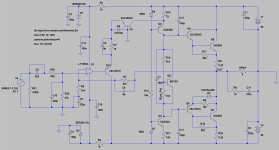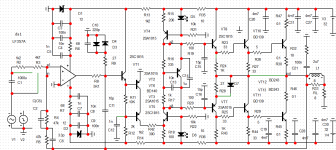If you increase Iq to 145mA the odd order harmonics will decrease even further. Excellent work Minek. Thank you!
At first glance similar to this power amp:What an interesting design, particularly the area around Q1 and the feedback networks.
file:///C:/Users/admin/Downloads/phase-linear_400_series_mk2_sm.pdf
very good circuit description is also included
Attachments
Last edited:
@minek123 Just a suggestion: Use LED in VBE multiplier to correct tempco curve. It gives better result than 1N4148.
It will still work, but with higher Thd, and possible other side effects.What happens if you short out R13
@minek123 Just a suggestion: Use LED in VBE multiplier to correct tempco curve. It gives better result than 1N4148.
Right, I saw Valery using it...
But with Quasi design, the tempco calculations are all messed up.
Upper temperature should be sensed on the upper driver, and lower temperature
on the output device (or the other way around),
so for any quasi design, temp sensing is whacked anyway..
Last edited:
@minek123 Just a suggestion: Use LED in VBE multiplier to correct tempco curve. It gives better result than 1N4148.
It is better to use a regular resistor there
No, this is different.At first glance similar to this power amp:
file:///C:/Users/admin/Downloads/phase-linear_400_series_mk2_sm.pdf
very good circuit description is also included
In parallel to this resistor R13 it is necessary to put the diode in direct connectionIt will still work, but with higher Thd, and possible other side effects.
It does, but to a lesser extent.
Why not three cascades ,but two ? I would also add a cascade to the VK ! With MOSFETs it is better in my humble opinion
Why not three cascades ,but two ? I would also add a cascade to the VK ! With MOSFETs it is better in my humble opinion
>It does, but to a lesser extent.
Perhaps. But - 90% of FET quasi amps that I've seen do not use it.
I tried builds of such amps with, and without it, and it does not
make any difference in the sim, measurements, and listening.
So I'm skipping it....
>Why not three cascades ,but two ? I would also add a cascade
to the VK ! With MOSFETs it is better in my humble opinion
Right, it would be better - but I didn't do it for BJT versions,
so for quasi, which is supposedly 'inferior', it makes even less sense 🙂
As quasi, this is not to be 'perfect', 'state of the art' amp.
I'm thinking about another future build similar to yours - LMK with output triple, but I wouldn't bother to do it for the Quasi version, which is being built for 'sentimental' reasons..
Perhaps. But - 90% of FET quasi amps that I've seen do not use it.
I tried builds of such amps with, and without it, and it does not
make any difference in the sim, measurements, and listening.
So I'm skipping it....
>Why not three cascades ,but two ? I would also add a cascade
to the VK ! With MOSFETs it is better in my humble opinion
Right, it would be better - but I didn't do it for BJT versions,
so for quasi, which is supposedly 'inferior', it makes even less sense 🙂
As quasi, this is not to be 'perfect', 'state of the art' amp.
I'm thinking about another future build similar to yours - LMK with output triple, but I wouldn't bother to do it for the Quasi version, which is being built for 'sentimental' reasons..
The amplifier is powered by a bipolar stabilized source with overload protection.Based on the kletsov amplifier.
Радио№7/1983
You can use a complementary output stage circuit.#255
My brother made a quasi in 1988 with a triplet output.
Last edited:
>How can I set the quiescent current of cascaded BJT version? It seems to be very sensitive.
You mean R16 settings are too sensitive?
I guess in actual build it would be a resistor 500 Ohm,
plus a smaller pot in series.
Or some combination of a series and parallel
pot/resistor to make the pot less sensitive.
I guess also changing the temp sensing transistor may affect this.
Try BD139?
You mean R16 settings are too sensitive?
I guess in actual build it would be a resistor 500 Ohm,
plus a smaller pot in series.
Or some combination of a series and parallel
pot/resistor to make the pot less sensitive.
I guess also changing the temp sensing transistor may affect this.
Try BD139?
TO-126. Resistor from base to collector. Resistor from base + trim to emitter. Smoother and safer 🙂
You mean R16 settings are too sensitive?
Yes. I found that R16=500 and 500 Ohm trimpot in series give the best result. Thank you.
HardCore 2N3055 quasi amp
Here is BJT quasi version, the most original as it can be:
with 2N3055 output, and Maxim's diode for lower driver.
Of course instead of 2N devices, modern ones can be used with small adjustments here and there, and with higher rails.
In sim: Total Harmonic Distortion: 0.000047%(0.000098%)
Let restore the time when dinosaurs were roaming the earth, and tubes were slowly fading out of fashion...
Here is BJT quasi version, the most original as it can be:
with 2N3055 output, and Maxim's diode for lower driver.
Of course instead of 2N devices, modern ones can be used with small adjustments here and there, and with higher rails.
In sim: Total Harmonic Distortion: 0.000047%(0.000098%)
Let restore the time when dinosaurs were roaming the earth, and tubes were slowly fading out of fashion...
Attachments
Here is BJT quasi version, the most original as it can be:
with 2N3055 output, and Maxim's diode for lower driver.
Of course instead of 2N devices, modern ones can be used with small adjustments here and there, and with higher rails.
In sim: Total Harmonic Distortion: 0.000047%(0.000098%)
Let restore the time when dinosaurs were roaming the earth, and tubes were slowly fading out of fashion...
Awsome. Better than any of previous version. 🙂
On the most affordable and inexpensive parts .
Wow. Triple quasi output. Would you share some sim results with us?
- Home
- Amplifiers
- Solid State
- Unusual amp from 1987

